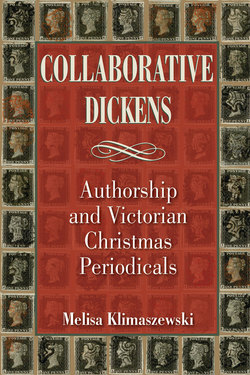Collaborative Dickens

Реклама. ООО «ЛитРес», ИНН: 7719571260.
Оглавление
Melisa Klimaszewski. Collaborative Dickens
Отрывок из книги
Collaborative Dickens
Series editors: Joseph McLaughlin and Elizabeth Carolyn Miller
.....
As is already apparent, I use the term collaboration to refer to multiple ways of writers producing texts together. In practice, collaboration includes all sorts of interactions that extend past two people sitting in a room together while one of them writes ideas down on a page. Seth Whidden’s work takes nineteenth-century French literature as its subject and provides useful grounding concepts. Whidden separates intertextuality from collaboration and takes care to point out that agency is associated with the latter but not the former: “Collaboration refers specifically to the relationship between two or more agents at some point during the creation of a literary text, whereas intertextuality refers to the relationship between two or more texts; the former emphasizes the process, the latter the results.”36 One of the most fascinating aspects of these Christmas numbers is the way in which they inconsistently interweave both collaboration and intertextuality. In a given issue, Dickens (and others) might participate in conversations affecting the text or have no direct communication at all. One contributor, for instance, might talk to Dickens about the frame narrative or the content of a particular story, while another contributor sends in a submission and hears nothing further. Or Dickens may send in stories from afar while Wills has conversations with others about the number’s shape. In the analyses that follow, I show that one must allow for the operation of both models and, most importantly, read from the text outward rather than imposing a strict model a priori based on unstable biographical evidence or unquestioned critical norms. In most scenarios, a critic can expect to be able to differentiate instances of what Whidden calls “collaboration in praesentia,” when writers are together physically during the creative act, from “collaboration in absentia,” when the writers are physically apart.37 The Christmas numbers, however, force readers to consider both modes simultaneously.
Laird’s work on feminist modes of collaboration suggests new paradigms that are helpful in thinking about collaboration that happens in multi-gendered groups. Especially useful to this study is a “model of coauthorship as distinct from both solitary genius and an authorless textuality. In this model a large range of different kinds of coauthorship includes, surrounds, and renders anomalous the idea of the autonomous, original author.”38 To address this variation in collaborative method, we must accept both “partial collaborations, in which full mutually acknowledged coauthorship does not occur” and “full collaborations,” and we must avoid viewing full collaborations as “necessarily more balanced, more equitable, or more mutually rewarding than partial or ‘approximate’ . . . collaborations between authors and editors, speakers and writers.”39 Granting legitimacy to varying degrees and types of coauthorship means that one can no longer disqualify a text from the “collaborative” category based only on a printed byline or lack thereof. In part because I am persuaded by Laird’s argument against “authorless textuality,” my suggestions for how to rethink Dickens as a collaborative entity sometimes echo Marjorie Stone’s and Judith Thompson’s formulation of the author as heterotext without adopting their stance completely. Although Stone and Thompson intend to return “hetero” to its “older root,” which includes meanings such as “mixed,” I am not convinced that the prefix lends itself to the kind of intermittent blending evidenced in the Christmas numbers or that it avoids obliterating human agency.40 In the case of an editorial authorial presence such as Dickens, the texts he published at times fit into a heterotextual model of mixture but at other times are unable to achieve narrative coherence. Therefore, rather than pursuing a theory of collaboration as heterotext, I am more compelled by extending and expanding the notion of collaboration as conversation.
.....